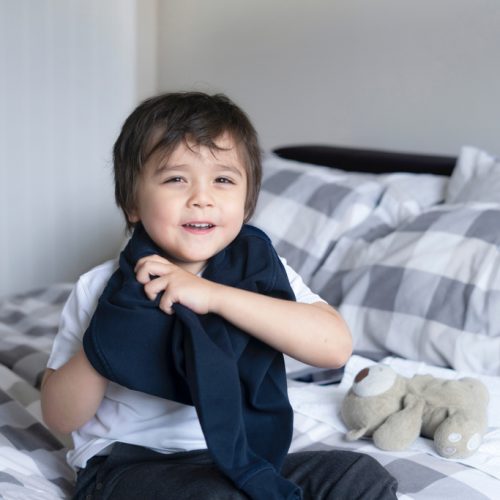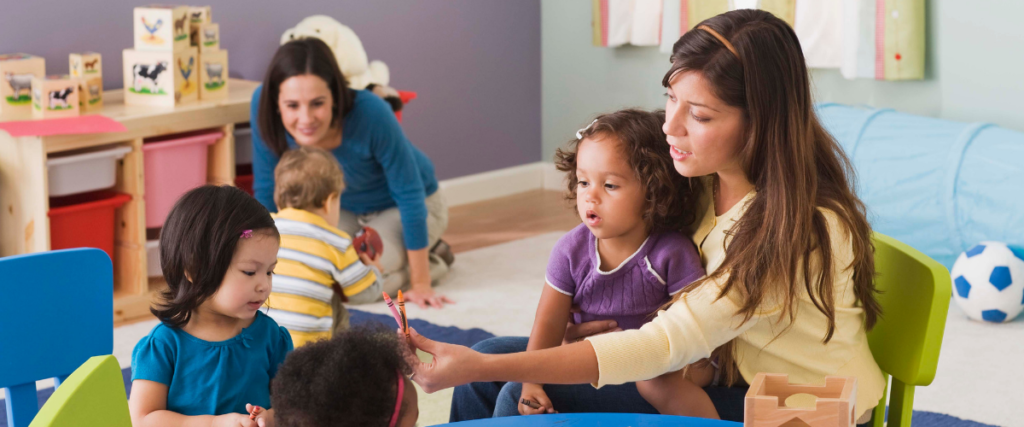The main takeaways for this guide take less than 1 minute to read. It contains information from seven sources, including the American Academy of Pediatrics and the CDC. See the full list below.
This guide will be updated again in September 2021. Know something we should add? Email us.
Dressing your children is one of those basic things you do for them, day in and day out, until one day it dawns on you that they might be able to do this themselves. (Or…they force they issue.)
At what age can kids dress themselves? We went through a few different sources to get the low down on when your kids can dress themselves and how to help them.
The main takeaways:
- It’s a range (as always), but most sources concluded that kids should be able to dress themselves around Kindergarten age, i.e. 5-6 years old.
- It’s something we do every day so it’s easy to take it for granted, but getting dressed actually involves a lot of cognitive and motor skills. And that can explain why kids learning to dress themselves often happens bit-by-bit over a longer period of time.

General Agreement Around Kindergarten
The sources we reviewed varied on when kids should be able to dress themselves, but most were in the general vicinity of 5 years old.
The American Academy of Pediatrics recommends parents encourage independence in getting dressed for kids ages 4-6. They suggest laying out an outfit the night before so your child can get dressed without having to focus on anything else.
The CDC says children should be able to dress themselves and tie their shoes by “middle childhood,” which they define as 6 to 8 years of age.
Rebecca Jackson, a neuropsychological educator and co-author of The Learning Habit, a book on helping kids learn good habits and chores, broke down getting dressed in the following categories:
- Preschoolers: You can expect them to help pick out their clothes (she suggests giving limited options), but not to fully dress themselves yet.
- Kindergarten: Kids this age can lay out their clothes the night before and mostly dress themselves, but they will need help with buttons and tying.
- First grade: Set out clothes themselves and get dressed. Also able to put clothes away into drawers.
There are a few sources that say younger children should be able to dress themselves, some as early as three years old. Dr. Kyle Pruett, a child psychiatry professor at Yale, wrote an article encouraging parents to give their kids autonomy and letting them “figure out how to do things themselves, messy as it may be at the start.”
He recommends letting three-year-olds dress themselves (with supervision) and says by five children should be able to pick out their own clothes, too.
And occupational therapist Christie, the author of the MamaOT blog, has a great list breaking down about when kids will typically be able to do very specific elements of getting dressed (i.e. taking off a hat versus taking off a pullover shirt).
Below is a short summary of her milestones, but the whole thing is a good encapsulation of how many different elements there are to getting dressed, which is why there isn’t a hard and fast age:
- By 3: Take off front opening clothes, put on coat, put on pullover shirts with supervision, still needs help with right foot
- By 4: Puts on sock all the way, can take off most pull over clothing, puts shirt on in the right direction
- By 5: Gets fully undressed on their own without reminders, can dress independently when asked
Ultimately though, she concludes that “given appropriate opportunities, instructions, and expectations, kids should be able to independently dress themselves around Kindergarten age. While that doesn’t mean they won’t need help here and there for tricky shoes or stubborn zippers, they should be able to meet most of their basic self-dressing needs by this age.”
Learning to Get Dressed Actually Involves Lots of Steps
The MamaOT article also explains why getting dressed is a big deal. She writes that occupational therapists “know from experience that kids’ ability to dress themselves plays a big part in relieving family stress and improving family routines. This is true whether a child has a disability or not.”
In addition to relieving family stress, getting dressed covers lots of skills, including “building up strength, range of motion, coordination, memory, sequencing, spatial awareness, and body awareness.”
There are three different skill sets your child has to master in order to dress themselves, according to Emily Austin, an occupational therapist interviewed by Parents.com:
- Gross motor: Movements like lifting arms and legs to put on clothes or take them off
- Fine motor: Using fingers to make things like buttons or zippers work
- Cognitive: Understanding what order clothes should be put on and what is appropriate for the weather
What To Do If Your Child Is Struggling
If your child is having a hard time getting dressed on their own, the first question to figure out is whether it is a motor skills issue or a cognitive one (or both.) A pediatrician and/or occupational therapist can help you figure that out first.
If motor skills are the challenge, it might be that your child is struggling to take off their socks and shoes because they don’t have the strength or grip needed to complete that task. If that is the case for your young preschooler, it could be time for a more in-depth evaluation.
If your child is struggling with getting dressed and its clear it isn’t a motor skills issue (i.e. they are able to move and manipulate items to get dressed), it could be that “executive functions” are a challenge for them. The Child Mind Institute has advice on how to help them develop those executive functions, which include the skills we us all day every day to plan, organize, and make decisions on everything from how to brush our teeth to what order to cook dinner.
For something like getting dressed (which they say can take an extraordinarily long time for a child with poor executive functioning), educational therapist Ruth Lee recommended a checklist to eliminate the decision-making process that they end up getting stuck on: “Often these kids will get so wrapped up in the decision-making process that they never even start the task. Or, if they do begin, they’re constantly starting and restarting because they’ve thought of a better way to do it. In the end they’re exhausted when the time comes to actually follow though,” Lee said.
Sources
Growing Independence: Tips for Parents of Young Children – HealthyChildren.org
Study Finds Habits in Children Take Root by Age 9 | Psychology Today
Encouraging Independence in Young Children | Psychology Today
When Do Toddlers Start Self-Dressing? | Parents


